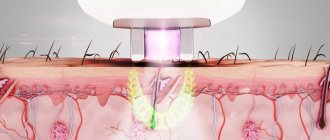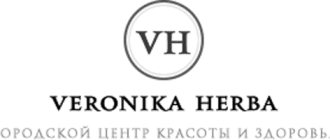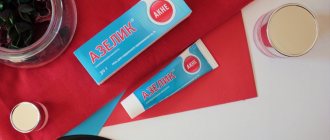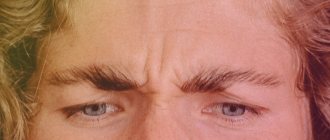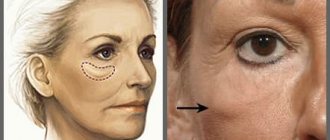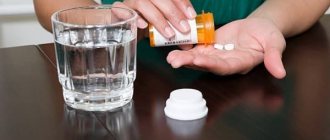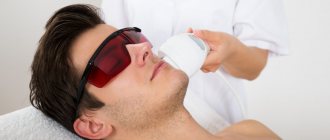Injection liposuction: how the procedure works
Injection liposuction begins with treating the skin in the area where the drug is administered with antiseptic agents. Then a cream or gel with a local anesthetic is applied to the skin, which reduces the degree of discomfort during the procedure (people with a low pain threshold may find injections of lipolytic solutions painful).
To eliminate local fat deposits in the face and neck (double chin), a special fan injection technique is used. The fan technique allows you to evenly distribute the active components of the solution in the tissues, achieve uniform destruction of fat cells, and obtain the most natural result.
The depth of the injections is the most important factor in the success of the procedure. If a lipolytic solution is used to correct aesthetic problems in the abdomen or buttocks, the needle is usually inserted to a depth of 10 to 15 millimeters. When rejuvenating the face, the depth of drug administration is always determined individually! The experience of a cosmetologist plays a decisive role here.
Direct injection of the lipolytic solution into the adipose tissue of the problem area lasts about 20 minutes. After completing the injections, the cosmetologist once again treats the facial skin with an antiseptic, and then applies soothing agents that will help reduce inflammation in the first days after injection lipolysis.
To achieve optimal results, the injection liposuction session should be repeated 3 to 8 times. The cosmetologist will tell you what the interval between sessions will be (this depends on the lipolytic used, the correction area, and the individual characteristics of the patient).
Chin fat not going away?
Sometimes getting rid of a double chin on your own can be an impossible task. Did the method described above not help you?
The list of probable causes is short:
- You expected to get the result very quickly, literally “tomorrow”.
- You don't have enough time to do double chin exercises and exercise every day.
- The chin was inherited from my parents.
- You are over 40 years old. At this age, loose skin on the chin practically does not tighten on its own and spoils the oval of the face even after massive weight loss.
- You have Central Asian, Caucasian or Slavic roots. The facial structure of these nations physiologically predisposes them to the appearance of a double chin even at a very early age.
But don't be upset. There are several extremely effective ways to remove a double chin quickly and without plastic surgery. Removing the double chin with lipolytic drugs will help.
What affects healing
First of all, it is necessary to remove sports and physical activity from life, especially when it comes to breast or buttock correction. It is also important to exclude thermal procedures - baths, saunas, hot baths. Heat promotes blood flow to injured areas and thereby increases the recovery period.
To recover, you also need to adjust your daily diet. During the rehabilitation period you will need to give up salt and spicy foods. Salt and hot seasonings retain fluid in the body, which increases the time it takes for swelling to resolve.
In the first days, puncture sites should be protected from water, and then protected from the sun. Solarium and beach are excluded for a month. When going out into the open air, injured areas should be protected from sunlight.
Michelangelo (Michelangelo)
New Italian cocktail. Unsurpassedly effective. Well tolerated. His reputation is as impeccable as the creations of the Maestro who gave him his name . It deservedly holds and is not going to give up the title of drug No. 1 in European Union clinics to anyone.
.
Injections for double chin Michelangelo is used for significant volumes between the chin and neck.
It will take about 4-6 procedures with an interval of 8-10 days. Sign up »
Review from Sergei, 35 years old:
“I went to the clinic regarding figure correction: stomach, back, sides, the so-called “lifebuoy.” I want to share with you my results after introducing the Italian cocktail Michelangelo
(
Michelangelo
). This is unreal!! In just two procedures, the waist size visually decreased (before the procedure 89 cm, after 87 cm), weight (up to 76.1 kg, after 74.6 kg). Easy and unobtrusive, without grueling trips to the gym - a very good result in a short time!”
Medicines and physical therapy
Medicines and physical therapy procedures can also help remove swelling after lipofilling. Medicines include Traumeel, heparin ointment or Troxevasin. A course of antibiotics may also be prescribed to stop the infection.
From physical therapy, patients are most often recommended microcurrents, laser, magnetic or phototherapy. These procedures help resolve swelling and speed up healing.
Microcurrent therapy accelerates resorption.
It is important to remember that you absolutely cannot prescribe medications and procedures for yourself! All medical treatments and manipulations must be suggested by or agreed upon by a physician. Self-medication can only harm the patient. Before attending physical therapy or using medication, you should always consult with your surgeon.
Chin slimming with INNO-TDS
The Spanish drug INNO-TDS Draining ppc was created specifically to target fat traps, one of which is the fat under the chin.
It specifically destroys the membranes of fat cells and transforms solid fat into an emulsion that is easily processed by the body. Therefore, INNO-TDS eliminates even those local fat deposits that cannot be eliminated through fitness and diet.
It will take from 4 to 6 procedures with an interval of 14 days each. Sign up »
Types and mechanism of action of lipolytics
All lipolytic agents are preparations consisting of natural ingredients, mainly of plant origin. They are divided into two types, differing in their mechanism of action: direct and indirect.
- Direct lipolytic preparations contain 2 or more components of plant origin. After administration, they destroy the membrane of the adipocyte (fat cell). Fat comes out of the damaged cell, is absorbed into the lymphatic vessels and is utilized by the body.
- Indirect lipolytics are not capable of destroying adipocytes, but only promote the removal of fatty compounds from the cell. The adipocyte itself remains intact and retains the ability to re-accumulate fat.
Based on the mechanism of action, it becomes clear that the group of direct lipolytic agents has a more pronounced and lasting effect. They are used to reduce the thickness of subcutaneous fat in problem areas: chin, malar and cheek areas.
Indirect remedies are less effective and are more suitable for eliminating minor defects. They are also used to consolidate the results obtained after hardware methods of liposuction (laser, cryolipolysis, cold liposuction) or the introduction of direct lipolytics.
A separate group of drugs used to reduce the volume of the face and neck includes drainage agents. They do not affect adipose tissue in any way, but help remove excess water, which actively accumulates in the subcutaneous fat.
Aqualix: a new alternative to liposuction
Expert comment:
“The drug Aqualix was created by a Spanish professor of plastic surgery specifically for the correction of fatty areas on the face and body that are not amenable to weight loss.
It is injected through cannulas into the fat layer and destroys fat cells.
Using Aqualyx intralipotherapy, the surgeon achieves the same effect as after liposuction without an operating room, pain and anesthesia in literally 2-4 procedures.”
Maxim Vasiliev, plastic surgeon.
Review:
“To be honest, I didn’t even try to lose weight. My weight suits me quite well. But the “pillow” between the chin and neck is not.
I chose double chin injections as a method of solving the problem for one reason - it’s simple. No need to put in any effort
.
On Friday I asked to leave early and had injections in my chin. Of course, a little pleasant. But Anya has a light hand.
Saturday morning I woke up, stretched as usual, yawned - and my chin literally sunk into my neck. Such a pleasant and long-forgotten feeling!!! It was worth a little patience for this!”
Olga, 34 years old.
Sometimes simply removing a double chin with injections is not enough. The sagging skin fold left after getting rid of fat requires attention.
Strengthening your chin will help: myostimulation, microcurrent therapy, massage and the elastin Japanese cocktail “Sakura”, which is prepared individually each time for the needs of your skin.
When are lipolytics used?
Facial correction with lipolytics is the optimal method for eliminating age-related changes in the skin and getting rid of excess volume. Lipolytic therapy is used in the following cases:
- Excessive fat deposits in the facial area.
- Double chin.
- Correction of jowls - overhanging folds of skin over the lower jaw.
- Elimination of pronounced nasolabial folds.
- Cheek reduction.
- Contouring of the cheekbones by eliminating fatty tissue.
Lipolytic agents can be injected into any part of the body, but with a pronounced thickness of subcutaneous fat (for example, in the lower abdomen, thighs or buttocks) they are rarely used due to the need to administer a large volume of the drug.
Photos "before" and "after"
Photos “before” the operation and on the 5th day “after”.
Reduction of the cheeks and formation of sunken cheekbones, installation of a Medpor chin implant (USA), laser nanoliposuction of the chin, thread lifting of the lower third of the face. Surgeon - Iskornev Andrey Alexandrovich.
You can ask your questions and sign up for a consultation by calling:
in Moscow, +7 495 989-21-16
in Kazan
Make an appointment online to receive a 30% discount on your consultation. Or buy a clinic certificate and pay for any procedures with a 10% discount.
Procedure
Lipolytic agents are administered by injection. Before starting the procedure, the doctor determines the injection area and treats the skin with antiseptic agents to avoid infection. The problem area is pricked with a thin needle. The depth of administration of the lipolytic agent depends on the thickness of the skin and subcutaneous fat. The duration of the procedure itself ranges from 5 to 20 minutes. To achieve the desired result, several sessions of lipolytic therapy may be needed with breaks of 1 to 4 weeks.
Currently, non-injection methods of administering lipolytic agents are actively used: phonophoresis, laser technologies. The opinions of cosmetologists vary - some believe that the distribution of the drug is the same as with injection, others talk about lower absorption using hardware methods. ProfMedLab uses a well-proven injection method.
There are no significant restrictions after the procedure. For 24 hours after lipolytic therapy, you should not wet your face and it is recommended to avoid cosmetics, baths and saunas for several days. Otherwise, you can stick to your usual lifestyle.
Effects of use
You can see the first changes after 1-2 mesotherapy sessions. Patients and cosmetologists note:
- Restoration of facial oval, elimination of gravitational ptosis;
- Disappearance of double chin, bags under the eyes;
- Improvement of the relief of the cheeks, disappearance of puffiness;
- Reduction in the volume of the abdomen, limbs, buttocks;
- Disappearance of excess fat on the chest and shoulders, “widow’s hump”;
- Reduction of signs of cellulite.
Lipolytic injections remove toxins and excess fluid from the body. The result depends on skin type, age, and severity of the problem.
When should you visit a doctor?
Let us remind you once again that tissue swelling at the surgical site is a completely normal phenomenon and should not cause concern. But in some cases it is worth visiting your surgeon as soon as possible:
- the temperature stays above 38°C for several days,
- swelling increases greatly in size,
- severe and growing pain at the surgical site over time,
- suppuration at the suture sites.
Any unusual situations that cause concern require an immediate visit to a doctor. Do not worry if there is slight pain, loss, or, on the contrary, increased sensitivity in the operated area. Like swelling, this is normal and will go away over time.
In other situations, you should not postpone a visit to the surgeon. In emergency cases, it is better to call an ambulance. Fortunately, complications after lipofilling are not that common. Most patients undergo surgery without any complications or problems.
Gel protrusions and migration
Migration, protrusion of the gel after plastic surgery is an extremely unpleasant reaction. The gel begins to appear outward, forms unevenness and blackheads, and with very thin skin it can appear as purple or blue spots. The reason for this phenomenon is insufficiently deep injection of filler. If the master injects the gel too deeply, the drug may begin to move to neighboring tissue areas and distort their proportions. The problem can be solved by introducing hyaluronidase, a component that breaks down and removes incorrectly administered hyaluronic acid.
What is the lipolysis procedure and what is its essence?
Lipolysis is a natural process that constantly occurs in the body, breaking down fat reserves into fatty acids and glycerol under the action of certain enzymes, in particular lipase. This principle underlies the salon procedure of the same name.
During lipolysis, one fat molecule is divided into three separate fatty acid molecules and one glycerol molecule.
Many people do not see the difference between lipolysis and liposuction. These are two completely different methods. Liposuction involves non-surgical intervention, and lipolysis is a non-surgical method of getting rid of fat reserves.
The essence of the procedure is the breakdown of fats. Unlike liposuction, they are not removed from the body. The lipolysis procedure simply “spurs up” the process of biochemical breakdown of fat. It can be performed on different parts of the body. Lipolysis is often practiced as the only way to remove a double chin.
Most often, lipolysis is performed on problem areas such as the abdomen, inner thighs, shoulders, and back. As a result of the procedure, fat cells are not removed or damaged, they are simply “deflated” – reduced in volume.
Vascular injuries (ischemia, embolism) after contour plastic surgery
Compression of blood vessels occurs when low-viscosity filler enters the vascular lumen or the drug is administered too deeply. During the day, pain increases, unhealthy redness may appear, severe swelling develops, and then necrosis with tissue scarring. This is the most severe, although rare, complication. Reasons for its appearance:
- a significant volume of gel was injected in close proximity to the vessel, as a result of which it strongly compressed it and closed the passage for blood;
- the filler entered directly into the vascular lumen, as a result of which it closed and the blood flow stopped.
Embolism and ischemia are characteristic of areas with an active blood supply - the nasolabial triangle, lips. The injured area is very painful, the area deprived of normal blood supply turns white, and a burgundy or blue mesh forms around it.
This condition requires an immediate response. Only a doctor can stop the situation, for which there are special protocols for administering the enzyme hyaluronidase and other methods of medical care to the patient.
Inflammatory processes at injection sites
A minor inflammatory reaction is considered a variant of the norm - it develops as a result of a foreign substance entering the body (despite the complete biocompatibility of hyaluronic acid with the human body, fillers trigger standard protection against “external invasions”). If the process takes place in 1-3 days, everything is fine, if it persists for a longer period:
- an infection has penetrated into the tissue - with injections (due to improper treatment of the skin before injections, or the use of a low-quality drug or consumables);
- the injection provoked an exacerbation of the infection, which was “dormant” in the tissues;
- There are autoimmune pathologies, against the background of which, as a result of the injection of filler, the patient begins to experience uncontrolled inflammatory reactions in the treatment areas.
To effectively treat a pathological condition, it is important to accurately determine the cause of its development; based on the results, the patient may be prescribed antibiotics, NSAIDs, antihistamines or steroids.
Advantages and disadvantages
Why patients choose injections with lipolytics:
The procedure is cheaper than plastic surgery or hardware, but gives a similar result.
No special preparation is required for the session.
There is no recovery period in the hospital.
The manipulation is performed without incisions or general anesthesia.
Lipolitics have an organic composition and do not accumulate in the body.
However, the procedure has its drawbacks:
The procedure with direct lipolytics is painful, so a local anesthetic is used.
It may cause allergic reactions.
Lipolysis activates lymph flow and blood circulation and affects the functions of the liver, heart and kidneys.
To maintain the result, the patient must follow the correct diet and consume enough clean water - at least 1.5-2 liters per day.
The procedure has contraindications and side effects.
What risks are possible with lipolysis?
In fact, the liposis procedure is in many ways similar to the natural process of fat burning in the body, so the risks are minimal, but they still exist. Since destroyed cells are excreted through the liver, the load on it increases significantly. Before prescribing lipolysis, a good specialist will make sure that the patient’s liver is in order and its reaction to the frantic regime will be adequate. With caution and only after consultation with a doctor, laser lipolysis can be performed for people with poor blood clotting.
Lumps, lumps, fibrosis, granulomas
Consequences such as granulomas, fibrosis, compactions, lumps, contour plastic surgery usually result from non-compliance with hygiene rules, the use of uncertified fillers or the illiterate work of a doctor. Fibrous capsules are also formed due to the wrong choice of filler type or dosage; they should be treated with antibiotics and anti-inflammatory drugs. Lumps and lumps can resolve on their own; granulomas can be removed surgically.


